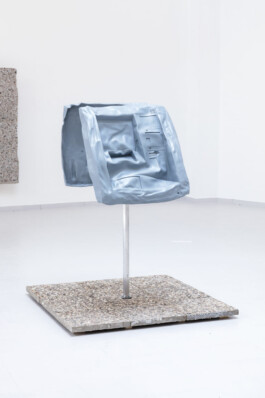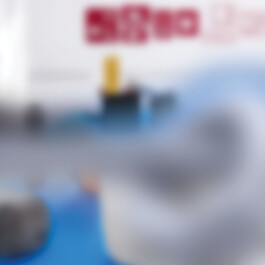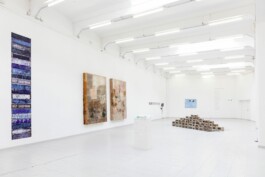In Conversation with
Konrad Hanke
Konrad Hanke, Artist Talk
Konrad Hanke, Exhibition View, 2021

Konrad Hanke, Artist Talk
Tanja Heuchele: Your life without art would be….
Konrad Hanke: Well, I don’t know. Different, I think. I’d probably have less time to read and catch up on things that interest me.
TH: Where do you get your inspiration from?
KH: It’s hard to say. I just collect different things that interest me to start with. Something will come to me and eventually, it will turn into something like an idea. Lately, I’ve been getting some ideas from different jobs I’ve done over the last few years to pay my rent. That kind of gives me some insight into things outside of my own bubble. And of course, people who are close to me, other artists, and talking to them are always a very big source of inspiration.
TH: When did you start with the project Informal City Park and what attracted you most?
KH: I started thinking about it at the end of 2019. I’ve known Gabriela for quite a while and I was excited when she asked me if I wanted to be part of the project. Because I found the idea of combining the concept of theme parks and informal living very interesting. I was particularly attracted by the opportunity to explore the topic and was very curious to see where my subjective process would take me. I was also attracted to the idea of bringing artists from Egypt and Germany together to see what these different positions would bring to the overall project.
TH: What literature did you study during the lockdown phase of the project?
KH: I read some texts about simulation, amusement parks, and urban space. What I really liked was the small collection of essays by Norbert Loacker (“Was Massen mögen”) and the book “The City as Theme Park and the Theme Park as City” by Stacy Warren. The contents of both books became important during my process of creating the artworks for the exhibition.
TH: What is your work about?
KH: At the moment, I am interested in simulations, for example, spatial concepts in video games. These always need translations between the world you experience as real and the model of that world. Translations that make sure you identify the model in the right way. In this context, I ask myself what details are needed to construct something that gives the feeling of “reality” and which are superfluous. Therefore, my work now physically revolves around these questions.
TH: How do you see the interplay between amusement park and slum?
KH: Well, I only know as much about slums as you can if you live in a Western European city. So I focused on the concept of amusement parks. What I can say is that amusement parks have to strongly control their space in order not to lose control of the narrative that is served in them. They have to prevent random things from happening in order to keep the story stable. Which in a way puts them at odds with urban areas. However, urban spaces always seem to me to be a big pile of disconnected and connected things happening at the same time. The staggering and layering of images in urban space, the eclectic about it has always interested me. Things happen and they look random – but they’re all part of a larger, more complex structure that you can never fully understand. I suspect that carries over to informal settlements as well, probably even more so because the state organizational structure is less present. Amusement parks, on the other hand, always try to create seemingly complex narratives/images that take place under controlled conditions. In this, I see amusement parks very much related to gardens, artificial spaces that try to simulate something that could also be scary or over-complex in real life. They try to turn that chaotic element into something appealing, domesticated. It is this shift that catches my attention the most.
Konrad Hanke, Exhibition View, 2021

Konrad Hanke, Artist Talk
TH: How was your working process, the interactions with the other artists, and the relationship to the exhibition space?
KH: Because of the various blockings, the process was much longer and more diffuse than I had expected. But I mostly enjoyed the time I had to reflect and read. Unfortunately, due to Corona, there was no possibility for the artists from Egypt to come over to Leipzig. That took away many possible interactions. I still really enjoyed seeing different perspectives on the subject and hearing different experiences within the given circumstances. I really like the exhibition hall and especially the light in it. For me, it always felt like a very challenging space because of the different spatial conditions. So it was exciting to think about how to use the space in the exhibition.
TH: How do you look at your hometown today? Has your perception of the city changed?
KH: How has it changed? Every city changes a lot over time. And I guess that’s part of it. And with that, individual perceptions change as well. But as an artist, I can’t welcome a lot of developments in rent, gentrification processes, and certain urban planning decisions. My overall perception hasn’t changed that much, but of course, there are details that I pay more attention to than before the project. To give an example, I look out more to defensive structures in architecture and public spaces. Often the finished process of creating an artwork changes the perception I have towards certain objects, which happened here as well.
TH: What moments will you remember in the future when you look back on the informal city park project?
KH: I think I will remember the whole process rather than individual occasions. Especially the moments when ideas took shape in conversations with the other participants and colleagues.
TH: What do you enjoy about your life as an artist?
KH: (myself (hahaha)). I like that I can shape the work process according to my personal needs. Following my own interests and being able to make things look the way I want them to look is probably the greatest thing for me.
TH: What is great art for you?
KH: Every time I see or experience a new piece of art, my idea of great art changes. So this is something I can’t possibly give a definitive answer to.
TH: Your next projects, exhibitions. Where can people see you?
KH: I have an exhibition together with Maximilian Stühlen, combined with a small artist residency: “unending hollow / cached debris” at Shed Eisenwerk in Frauenfeld/Switzerland. Opening June 16, 2021.
Related Topic
More Interviews




